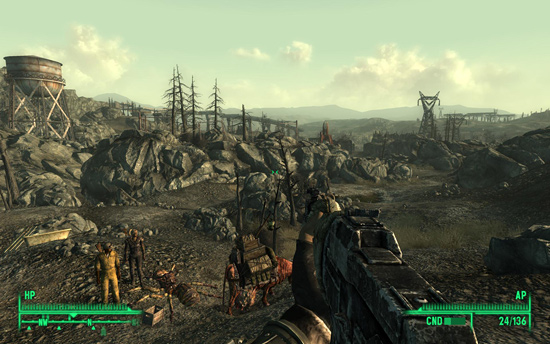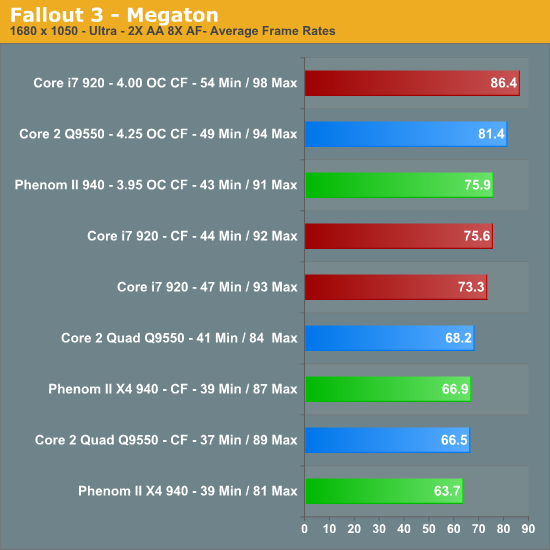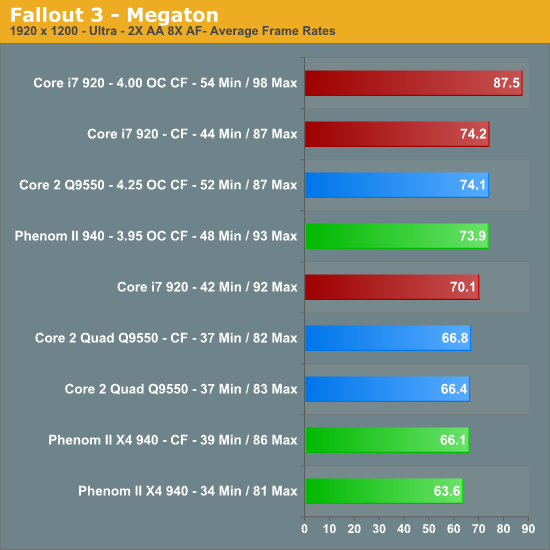CrossFireX and the Phenom II X4 940 – Competitive or Not?
by Gary Key on February 2, 2009 12:00 AM EST- Posted in
- Motherboards
Fallout 3

We have played this game numerous times and still have not visited every location on the map or completed all seventy or so side-quests. It could be that the game’s ambiance does not seem to match its predecessors. Alternatively, maybe some of the bugs present that result in NPC characters disappearing have us longing to play Oblivion or KOTR again. Even so, we still love the game. We have moved on to playing the new content pack, Operation: Anchorage, until Dragon Age: Origins ships.
The game engine is based on the one utilized in Oblivion with a few updates, so performance is similar. We set the quality settings to Ultra, AA to 2x, and AF to 8x. Our test consists of following a path back to Megaton and in the process fighting off a couple of Raiders. We utilize FRAPS to capture our results.

Truthfully, this game does not benchmark well. The game’s level-of-detail mechanism makes constant changes as you cross the map. The LOD adjustments create a seesaw effect in the frame rates and it is difficult to tell if the sudden pause or shudder in frame rates is from the video card or the game engine. That said, the Intel i7 platform simply performs best in this game.
Once again, in our single card testing at 1680x1050 each setup is very close with the Intel Q9550 holding a 4% advantage in average frame rates over the Phenom II 940. The Phenom II posts slightly better minimum frame rates once again. In CrossFire testing the Q9550 holds a small 1% advantage, close to our error of margin. The Q9550 picks up some steam when overclocked and holds an 8% advantage over the Phenom II 940 in average frame rates and 13% in minimum frame rates with a 7% clock speed advantage. The i7 leads our two competitors in overclocked CrossFire performance by 6% and 13% respectfully.
Adding a second card for CrossFire operation improves average frame rates by 4% and minimum frame rates stay the same for the Phenom II. The Intel Q9550 has an improvement of 2% in average frame rates and 11% in minimum frame rates. The Core i7 average frame rates improve by 3% and minimum rates decrease by 7%. Overclocking our processors resulted in a 14%~19% improvement in average frame rates with the Q9550 benefiting the most.

The 1920x1200 results are similar with the Q9550 and Phenom II 940 scoring nearly the same in single card and CrossFire. We just do not see any real benefits in having CrossFire at stock speeds with the Q9550 or Phenom II 940. Once we overclocked each processor, we noticed an 11% increase in CrossFire performance on these two platforms. The Q9550 holds a slight advantage in minimum frame rates with CrossFire when overclocked while the Phenom II 940 leads at stock clock speeds.
Adding a second card for CrossFire operation improves average frame rates by 4% and minimum frame rates by 15% for the Phenom II. The Intel Q9550 has an improvement of less than 1% in average frame rates and no changes in minimum frame rates. The Core i7 average frame rates improve by 6% and minimum rates increase 5%. Overclocking our processors resulted in a 12%~17% improvement in average frame rates with the Core i7 benefiting the most.
Our Core i7 scores better with a single card setup than the other two platforms with CrossFire. The same holds true with the stock i7 CrossFire results scoring higher than our two overclocked competitors do. Overclocking the i7 CrossFire setup results in a 17% increase in average frame rates that required a 50% increase in core clock speeds.
As far as game play experiences, we noted no differences between the Intel Q9550 and Phenom II 940 platforms. Each one offered a very good experience with minimum frame rates on each platform being acceptable. The amount of LOD adjustments in the game was disconcerting at times . When we experienced them, the game stutter was minimized on the i7 setup compared to the other two platforms with CrossFire enabled. All three platforms responded in the same manner with a single card setup. Overall, we would not recommend CrossFire for this game at present; even overclocking the processors resulted in a minimum improvement in frame rates.










68 Comments
View All Comments
Joe Schmoe - Tuesday, February 3, 2009 - link
This was a very good article. I'm not quite ready to build a new system just yet. But it is tax return season. I'm glad the Phenom II is competitive. We all win when AMD puts out a nice chip. I was about to jump on the I7 band wagon but decided to just grab a q6600 and save my coins for now. Hopefully this will end some of the endless flame wars going on through the forums.
Aquineas - Tuesday, February 3, 2009 - link
First of all, thanks for the hard work you put into testing. Many folks are getting hung up on 5-10 percent performance differences and making a big deal out of it . I think the most important part of the article is the part where it says, repeatedly (paraphrased):"We couldn't perceive a difference in gaming performance between platforms."
That being said, I think 18 months from now we'll see more games where the CPU differential matters more, which is right around the time I'll be doing my next system build.
myterrybear - Tuesday, February 3, 2009 - link
I agree with this as well, great job on the article & shows the point as I have ALWAYS said, when it comes down to it would ya even notice the diffrence between the 2 if you had just sat down on it & started to do stuff on it ??Yeah exactly 6 or 8 gig ram on Phenom II would be interesting, I know I've found 4 gigs on Phenom I to be very nice now that I am running a full 64bit os ( win 7 beta) on a oc to 3 ghz Phenom 9850 be. I'm just awaiting to see how things will be once I get my Phenom II 940 any second now. :)
myterrybear - Tuesday, February 3, 2009 - link
My thing that I am noticing with all these tests of core i7 vs phenom II is the fact the systems are not even ramwise. I mean what would a core i7 run like with 4 gigs of ram or if the phenom II platform had 6 gigs of ram.it's a valid argument I think.
Aquineas - Tuesday, February 3, 2009 - link
Honestly, it probably wouldn't matter much. If I were the author I'd re-run the test with 8GB on the PII, but it's probably less than a 2 percent differential.BlueBlazer - Tuesday, February 3, 2009 - link
Love to see Intel and AMD in SLI numbers!ThePooBurner - Monday, February 2, 2009 - link
Am i the only one that noticed that the results for the PhenomII were just about identical between resolutions? There should have been some form of difference unless the AMD platform is being artificially hard-capped for some reason. Otherwise that the frame rates would be identical when upping the resolution makes no sense at all. I suggest looking into it further.ThePooBurner - Monday, February 2, 2009 - link
Err, Crysis Warhead is what i meant by FarCray2.7Enigma - Tuesday, February 3, 2009 - link
This is a perfect example of why the full data is so incredibly important in teasing out the details.Yes if you look at the graphs they show a very close clustering for the single card, CF, and overclocked CF, but if you look to the right of the names you will see the min and more importantly max will scale with upgraded components. Not to the same level as one would like but there appears to be some really REALLY rough sections as the min frame rate is almost identical across the board (look at single vs. CF you see the same frame rate). That is probably due to some driver issue where both cards are not being utilized and the single card is not optimized well either.
ThePooBurner - Wednesday, February 4, 2009 - link
I think you are missing my point. When going to a higher resolution it is expect that the frame rates for a card will change. Both the min and the max as well as the average. In almost every single game tested the values for the ATi cards at all resolutions are nearly identical. This smells very fishy to me and makes me think there is some sort of artificial limit being placed on the ATi hardware.